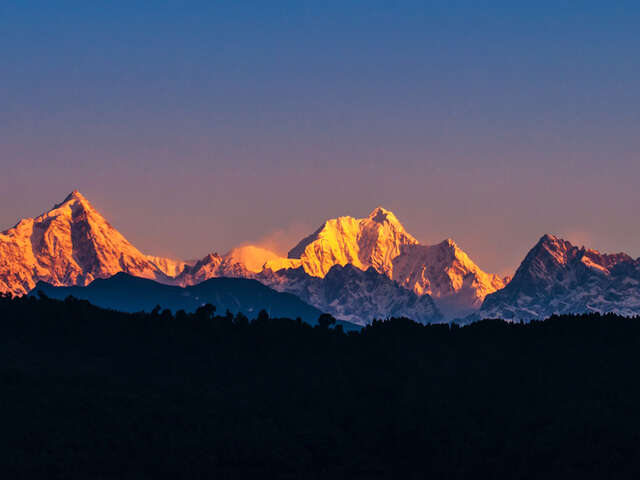Kanchenjunga, the third highest mountain in the world, stands majestically at 8,586 meters (28,169 feet) on the border of Nepal and India. Known for its breathtaking beauty and challenging climbs, the mountain draws trekkers, climbers, and nature enthusiasts from around the globe. However, understanding the temperature and climate of this region is crucial for anyone planning to explore its rugged terrain. This article delves into the temperature variations, seasonal changes and climatic conditions surrounding Kanchenjunga.
Geographic and Climatic Overview
Kanchenjunga is part of the Himalayas, a mountain range that plays a significant role in influencing the climate of South Asia. The region is characterized by its high altitude and varied topography, leading to significant temperature fluctuations. At lower elevations, temperatures can be relatively mild, while the higher altitudes experience harsh, frigid conditions.
The climate around Kanchenjunga can be classified into four main seasons:
- Winter (December to February)
- Spring (March to May)
- Monsoon (June to September)
- Autumn (October to November)
Each season brings its own Kanchenjunga temperature range and weather conditions.
Winter (December to February)
During the winter months, temperatures in the Kanchenjunga region can drop significantly. At base camp, temperatures can fall to as low as -10°C (14°F) or even lower at higher elevations. The weather is generally dry, but snow is common, especially at higher altitudes. The stark beauty of the snow-covered mountains attracts many photographers and trekkers willing to brave the cold.
Spring (March to May)
Spring sees a gradual warming as the snow begins to melt. Temperatures can rise to around 5°C to 15°C (41°F to 59°F) during the day at lower elevations, making it an ideal time for trekking. Higher altitudes still experience cold temperatures, often hovering around -5°C (23°F) or lower at night. The blooming flora adds vibrant colors to the landscape, enhancing the region's allure.
Monsoon (June to September)
The monsoon season brings significant rainfall to the Kanchenjunga region, with July and August being the wettest months. Lower elevations can experience temperatures ranging from 15°C to 25°C (59°F to 77°F), while higher altitudes remain cooler. The heavy rains can lead to landslides, making trekking hazardous. The clouds often obscure views of the mountain, but the surrounding valleys become lush and vibrant.
Autumn (October to November)
Autumn is one of the most favorable seasons for trekking in the Kanchenjunga region. The monsoon rains subside, and the weather becomes stable. Temperatures can range from 5°C to 15°C (41°F to 59°F) during the day, while nights can be cold, dropping to around -5°C (23°F) at higher elevations. The clear skies provide stunning views of Kanchenjunga and its surrounding peaks, attracting many trekkers during this time.
Temperature at Different Altitudes
Understanding the temperature variations at different altitudes is essential for climbers and trekkers. As a general rule, the temperature decreases as one ascends. The lapse rate, which is the rate at which temperature decreases with an increase in altitude, averages about 6.5°C for every 1,000 meters (3,281 feet) gained. Therefore, as trekkers ascend toward Kanchenjunga’s base camp and beyond, they should be prepared for much colder conditions.
- Base Camp (Approx. 5,000 meters / 16,404 feet): Temperatures can range from -5°C to 5°C (23°F to 41°F) depending on the season. Nighttime temperatures often drop below freezing.
- Higher Camps (6,000 meters / 19,685 feet and above): At these altitudes, temperatures can plummet to -15°C (5°F) or lower. The wind chill can make it feel even colder, creating challenging conditions for climbers.
- Summit (8,586 meters / 28,169 feet): The summit of Kanchenjunga experiences extreme cold, with temperatures often hovering around -30°C (-22°F) or lower. The wind can exacerbate these conditions, making it vital for climbers to be well-prepared.
Preparation and Considerations
Given the extreme temperature variations, proper preparation is essential for anyone planning to visit Kanchenjunga. Here are some key considerations:
- Clothing: Layered clothing is crucial. Base layers that wick moisture, insulating mid-layers, and waterproof outer layers are recommended. Don’t forget gloves, hats, and thermal socks.
- Acclimatization: Spend time at lower altitudes to acclimatize before ascending. This helps prevent altitude sickness, which can be exacerbated by cold temperatures.
- Timing: The best times for trekking are during spring and autumn when temperatures are milder, and weather conditions are more stable.
- Weather Monitoring: Stay updated on weather forecasts and be prepared for sudden changes in conditions, especially in the mountains.
- Hydration and Nutrition: Staying hydrated and well-nourished helps maintain energy levels, especially in cold conditions where the body burns more calories to stay warm.
Conclusion
Understanding the temperature and climate around Kanchenjunga is essential for a successful and safe trekking or climbing experience. With its stunning landscapes and challenging conditions, Kanchenjunga offers a unique adventure for those willing to explore its heights. By being prepared for the temperature variations and weather conditions, trekkers and climbers can fully appreciate the beauty and majesty of one of the world’s greatest mountains.





Comments